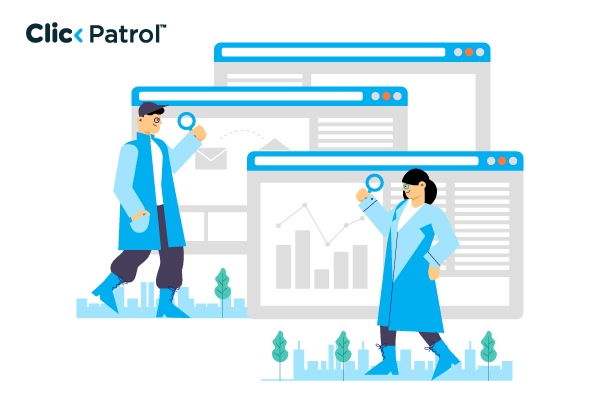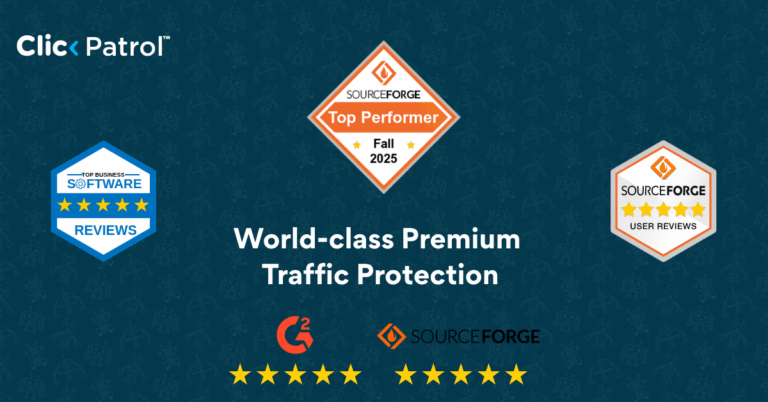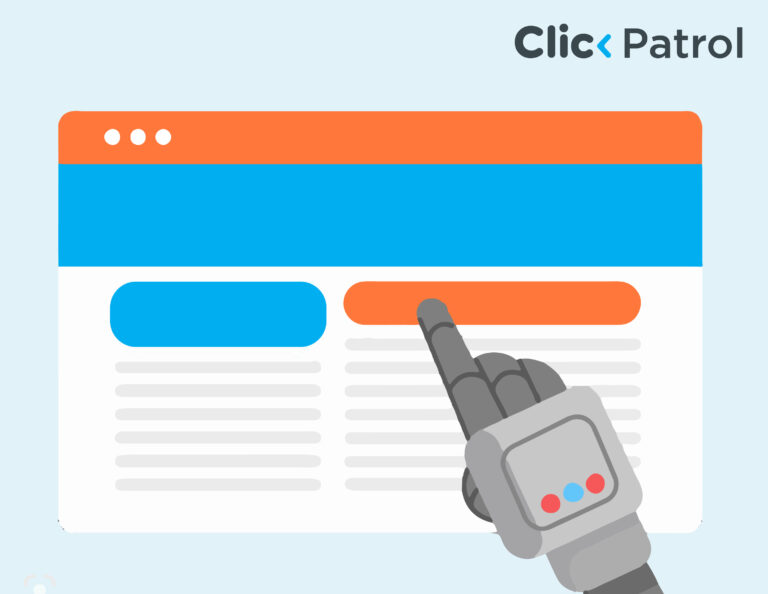Banner ad fraud is the practice of generating fake impressions or clicks with bots or scams, wasting the money spent on an ad and skewing the results.
How to detect banner ad fraud in 2025: Protect your ad spend with ClickPatrol
Abisola Tanzako | Nov 14, 2025

Table of Contents
- What is banner ad fraud, and how it harm advertisers
- Why banner ad monitoring tools are critical for detecting fraud
- How to spot banner ad fraud using monitoring tools
- Track traffic sources and referrers
- Analyze click patterns and behaviour metrics
- Check viewability and engagement metrics
- Use IP and device tracking
- Audit your ad placements regularly
- The risks of ignoring banner ad fraud
- ClickPatrol: Detect and prevent banner ad fraud effectively
- Automatic blacklisting of low-quality sites:
- Behavioural fraud detection:
- Detailed reporting:
- Customizable whitelists and blacklists:
- Maximized ROI:
- Proven strategies to avoid banner ad fraud
- Protect your ad spend and brand reputation
Banner ad fraud continues to be a major drain on advertisers’ budgets in 2025, with global losses estimated at over US $41.4 billion this year.
As digital marketing becomes more complex, fraudsters are deploying bots, fake impressions, and other schemes to steal value from campaigns.
This article will show you how to detect banner ad fraud effectively, highlight common tactics used by fraudsters, and explain how tools like ClickPatrol can help protect your ad spend while ensuring your campaigns reach real, engaged audiences.
By understanding the warning signs and implementing innovative monitoring strategies, you can safeguard your marketing investments and maximize ROI.
What is banner ad fraud, and how it harm advertisers
Banner advertising is a form of digital display marketing in which rectangular graphics appear on websites and applications, highlighting products or services.
Commonly placed at the top, bottom, or sides of a page, these ads drive traffic through persuasive images, text, and clear calls to action.
More often than not, however, the interactions are not organic. Banner ad fraud occurs when bots or fraudulent sites fabricate impressions or clicks to inflate results.
This invalid traffic wastes ad budgets, skews analytics, and lowers ROI. The detection and prevention of fraud will thus allow the advertiser to ensure genuine visibility, accurate insights, and proper audience engagement.
There are many types of banner ad fraud; among them are:
- Bot traffic: Programs that automatically run processes to simulate human behaviour, creating fake impressions or clicks.
- Click farms: Groups of poorly paid people clicking an advertisement manually to simulate engagement.
- Domain spoofing: Fraudsters disguise low-quality sites as premium publishers to command higher CPMs.
- Ad stacking: Multiple ads are layered on top of each other, so only the top ad is visible, but all are counted as “viewed.”
- Pixel stuffing: This means the ad was shrunk to an invisible 1×1 pixel, creating impressions no human could ever see.
- Incentivized or fake placements: Ads placed on irrelevant and/or misleading websites from which users are clicking unintentionally. The first step toward fighting banner ad fraud is recognizing it, and that is where monitoring tools come into play.
Why banner ad monitoring tools are critical for detecting fraud
It is usually hard to detect banner ad fraud with the naked eye. Scammers can make invalid traffic appear quite legitimate, and traditional metrics like impressions, clicks, or CTR do not always provide an accurate picture.
Monitoring tools provide advertisers with the much-needed insight to detect anomalies, analyze placements, and take corrective action.
These tools keep a close watch on where exactly the ads appear, who interacts with them, and whether the engagement matches that of an authentic user.
Without monitoring, you are flying blind, essentially investing in placements that can be hurting your brand or yielding zero real conversions.
How to spot banner ad fraud using monitoring tools
Banner ad fraud is a growing concern in 2025, costing advertisers billions in wasted spend.
Detecting it early is crucial to ensure your campaigns reach real, engaged users. Here’s how to use them effectively.
Track traffic sources and referrers
Legitimate ad placements usually come from reputable, contextually relevant domains. Sudden spikes in traffic from unfamiliar, low-quality, or unrelated sites are a warning sign.
Monitoring tools let you track the domains and URLs generating impressions and clicks. Look for:
- Domains with random or unusual names
- Sites unrelated to your niche
- Traffic is coming disproportionately from one or two sources
- Geographic locations outside your target market
Analyze click patterns and behaviour metrics
Fake clicks behave differently from those generated by real users. Monitoring tools can reveal anomalies that indicate automation or manipulation. Watch for patterns such as:
- Unusually high click-through rates (CTR) without corresponding conversions
- Multiple clicks in quick succession
- Very short session durations or high bounce rates
- Identical click timestamps from several users or IPs
- Clicks originating from data centers or proxy servers
Check viewability and engagement metrics
While fraudsters may inflate impression counts, engagement metrics often tell the true story. Monitoring tools can track:
- Dwell time
- Scroll depth
- Actual ad visibility
Low viewability rates, less than 30% or zero interaction metrics, may indicate:
- Ads placed below the fold, unseen by users
- Ads hidden in iframes or pop-unders
- Stacked or pixel-stuffed placements
Use IP and device tracking
IP addresses and device fingerprints are powerful indicators of banner fraud. Monitoring tools can track devices, browsers, and IPs that interact with your ads. Watch for:
- Multiple clicks from the same IP address
- Traffic from VPNs or proxy networks
- Unusual volumes of certain device types or outdated browsers
- Activity is heavily concentrated in data centres
- Monitor conversion quality
Not all conversions carry real value. Fraudulent conversions may include:
- Form submissions with fake or nonsensical information
- Leads using disposable email addresses
- High volumes of low-quality conversions from specific placements
Audit your ad placements regularly
Even with precise targeting, ad networks sometimes place your banners on low-quality or irrelevant sites.
Regular audits increase transparency and control. Use monitoring tools to:
- Generate placement reports listing all domains your ads appeared on
- Identify suspicious or underperforming sites
- Exclude or blacklist low-quality placements
- Whitelist reputable domains for future campaigns
The risks of ignoring banner ad fraud
Failing to account for financial losses, banner ad fraud hurts your brand and distorts your entire marketing campaign.
When banner ad fraud is left unchecked, it could lead to:
- Lost ad spend: the amount of budget wasted on fake impressions or clicks that could have reached actual customers.
- False analytics skew metrics, making it hard to optimise campaigns or even determine ROI.
- Brand safety risk: Advertisements on adult, extremist, or malicious websites will negatively impact the brand image and consumer confidence.
- Legal issues: There are strict guidelines in specific areas related to data privacy and ad transparency; fraudulent behaviour can put ad publishers unwillingly in danger.
ClickPatrol: Detect and prevent banner ad fraud effectively
ClickPatrol helps advertisers protect their campaigns from fraud by focusing on placement quality, behaviour tracking, and transparent reporting.
Automatic blacklisting of low-quality sites:
The platform identifies irrelevant or low-quality websites and ensures your ads only appear on reputable, contextually relevant domains.
Behavioural fraud detection:
ClickPatrol monitors click activity to distinguish bots and click farms from real users, filtering suspicious behaviour in real time.
Detailed reporting:
Advertisers receive clear, data-rich reports on ad performance and placement, enabling informed, data-driven decisions.
Customizable whitelists and blacklists:
You can create rules to control exactly where your ads appear, improving brand safety.
Maximized ROI:
By eliminating fake activity and low-quality placements, ClickPatrol ensures your ad budget reaches real users and drives meaningful engagement.
Proven strategies to avoid banner ad fraud
Even with tools like ClickPatrol, staying proactive is key. Here are the best practices to protect your campaigns over the long term:
- Set strict placement parameters: run ads only on verified, contextually relevant websites.
- Maintain and update whitelists and blacklists: Regularly review site performance data to refine which placements are allowed or blocked.
- Combine multiple data sources: Integrate ad network reports, analytics, and fraud-detection tools to provide a comprehensive view of campaign activity.
- Monitor campaign performance closely: look beyond basic metrics and track engagement, dwell time, and conversion quality to detect anomalies.
- Train your team: Ensure everyone involved in campaign management understands the signs of banner ad fraud and how to respond to them.
Protect your ad spend and brand reputation
Banner ad fraud silently drains budgets and undermines even the best-planned campaigns.
With the right monitoring tools, you can detect fraudulent activity, prevent low-quality placements, and safeguard both performance and brand reputation.
ClickPatrol helps you stay in control by automatically identifying and filtering out bad placements, ensuring your ads reach real, engaged audiences.
Start using ClickPatrol today to achieve cleaner traffic, smarter ad spend, and authentic interactions with the customers who matter most.
Frequently Asked Questions
-
What is banner ad fraud?
-
What should I do to spot banner ad fraud?
Monitor traffic sources, click behaviour, and placement quality using monitoring tools.
-
What is the mechanism by which ClickPatrol averts banner ad fraud?
ClickPatrol identifies and blocks low-quality, irrelevant placements and displays your advertisements only on reputable, high-performing sites.






